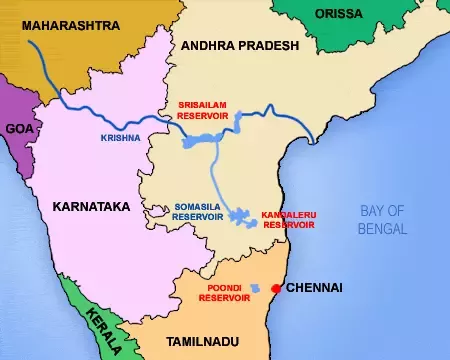Indian Polity
Krishna Water Dispute
- 11 Oct 2023
- 6 min read
For Prelims: Krishna Water Disputes Tribunal-II (KWDT-II), ISRWD (Inter State River Water Disputes) Act, 1956, Krishna River, Article 262 of the Indian Constitution.
For Mains: Krishna Water Dispute, Krishna Water Disputes Tribunal-II, Inter-state Water Disputes.
Why in News?
The Union Cabinet has approved the issue of further Terms of Reference (ToR) to the existing Krishna Water Disputes Tribunal-II (KWDT-II) under the ISRWD (Inter State River Water Disputes) Act, 1956 for its adjudication between the States of Telangana and Andhra Pradesh (AP).
What is the Krishna Water Disputes Tribunal-II (KWDT-II)?
- Krishna Water Disputes Tribunal-II was constituted by the Centre in April 2004 under Section 3 of the ISRWD Act, 1956 to adjudicate and resolve water-sharing disputes related to the Krishna River.
- It was constituted to address the allocation of Krishna River waters among the riparian states of Maharashtra, Karnataka, and Andhra Pradesh.
- KWDT-II made recommendations and allocations of Krishna River waters based on the availability of water, the demands of the states, and other relevant factors. It provided specific quantities of water to each state, outlining the share they were entitled to receive.
What is Krishna Water Dispute?
- About:
- The Krishna Water Dispute centers on the equitable sharing of Krishna River waters among the states of Maharashtra, Karnataka, Telangana, and Andhra Pradesh.
- The Krishna River flows through these states, and disputes arise due to differing needs, historical disagreements, and changes in the political and administrative landscape.
- Background:
- Point of Contention: The Srisailam reservoir, situated on the Krishna River in Andhra Pradesh, is a major point of contention. Andhra Pradesh contested Telangana's use of Srisailam reservoir water for power generation.
- Dispute Background: Disputes trace back to the formation of Andhra Pradesh in 1956 and were addressed through the Krishna Water Disputes Tribunal (KWDT) in 1973. A second KWDT was set up in 2004 to reallocate Krishna water.
- KWDT Allocation (2010): The second KWDT delivered its report in 2010, which made allocations of the Krishna water at 65% dependability and for surplus flows as follows:
- 81 TMC for Maharashtra, 177 TMC for Karnataka, and 190 TMC for Andhra Pradesh.
- Andhra Pradesh's Challenges: In 2011, Andhra Pradesh challenged the KWDT's allocation through legal proceedings, including a Special Leave Petition before the Supreme Court.
- In 2013, the KWDT issued a ‘further report’, which was again challenged by Andhra Pradesh in the Supreme Court (SC) in 2014.
- After the creation of Telangana, in 2014, Andhra Pradesh demanded a review of Krishna water allocations among four states.
- Maharashtra and Karnataka argued that Telangana was created following the bifurcation of Andhra Pradesh. Therefore, allocation of water should be from Andhra Pradesh’s share which was approved by the tribunal.
- Constitutional Framework:
- Article 262 of the Indian Constitution provides for the adjudication of inter-state water disputes, allowing Parliament to create laws for this purpose.
- The Inter-State Water Disputes Act (1956) empowers the Central government to establish ad hoc tribunals for resolving water disputes between states.
- Current Status:
- KWDT will provide new terms of reference under which the tribunal will divide the water of the Krishna River among both states, Andhra Pradesh and Telangana, in the future.
- It will allocate water on a project-wise basis for the proposed projects in both states that are intended for developmental or future purposes.
Krishna River
- Source: It originates near Mahabaleshwar (Satara) in Maharashtra. It is the second biggest river in peninsular India after the Godavari River.
- Drainage: It runs from four states Maharashtra (303 km), North Karnataka (480 km) and the rest of its 1300 km journey in Telangana and Andhra Pradesh before it empties into the Bay of Bengal.
- Tributaries:
- Hydropower Development:
- The major Hydro Power stations in the basin are Koyna, Tungabhadara, SriSailam, Nagarjuna Sagar, Almatti, Naryanpur, Bhadra.
- Mythology:
- Krishna is a mighty east flowing river of peninsular India. It is the same river as Krsnavena in the Puranas or Krsnaveni in the Yoginitantra.
- It is also known as Kanhapenna in Jatakas and Kanhapena in the Hathigumpha inscription of Kharavela.







